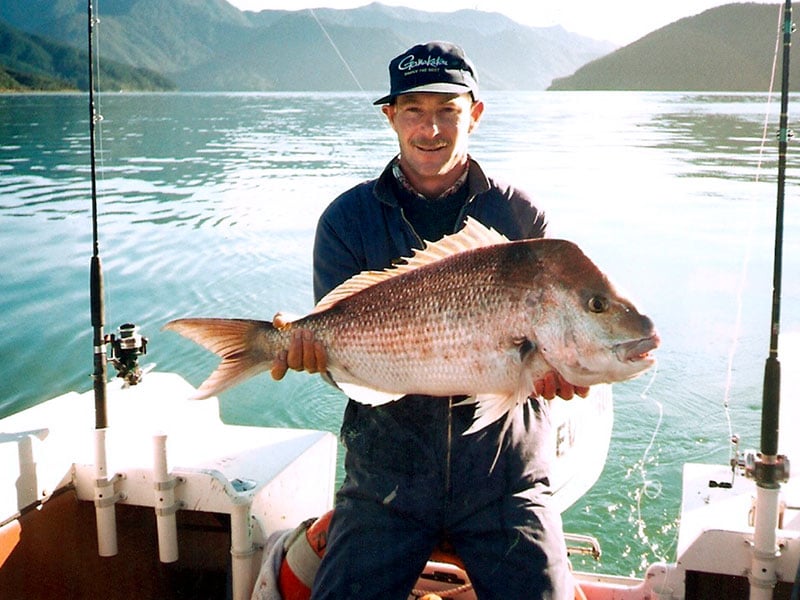Tackle and technique: scoring a big snapper in Marlborough Sounds
5 min read
Marlborough Sounds can produce big snapper. Photo: Ben Hope
Theodore Gordon, a noted American trout fisherman of yesteryear, wrote: “The great charm of fly-fishing is that we are always learning.”
It’s that intangible uncertainty, the challenge that makes trout fishing addictive.
The same can be said for snapper fishing especially in my home patch of the Marlborough Sounds. I liken Marlborough Sounds snapper to brown trout in the need for success. You’re constantly learning.
My first encounter to Marlborough Sounds snapper was in the 1970s. I initially just fished from the shore and caught snapper here and there on surfcasting gear, but it Jim – a friend from Nelson – who introduced to me to a new style of light spinning tackle. We fished out from Nelson’s Little Kaiteriteri in a three-metre dinghy and using light gear, landing several snapper of about 2kg each.
The idea had originated with a friend of Jim’s – Dave – who used trout spinning gear on snapper on the mudflats of Auckland. He found that by using lighter gear, he was able to take snapper when the heavier orthodox tackle failed. In essence, Dave and Jim were the fore-runners of today’s light tackle snapper approach with soft bait rods.
In Marlborough, I applied the same technique and found it successful on shallow mudflats and channels, particularly on an incoming tide. I worked with one chap who was a keen snapper fisherman, but he never caught much. He used to launch his boat at the same place near the head of Pelorus Sound.
One reason for his lack of success was because he used the then-traditional gear. Rods used in those days could be likened to broom handles; such was their stiffness. No doubt frustrated at his lack of success, he would tail me, anchor just 30 metres away and fish. I don’t think he ever realised it was the tackle and technique that spelt the difference and not fishing location. It was his failure to learn and adapt.
There are several basic requirements for catching snapper in the Marlborough Sounds that I gleaned from top Marlborough Sounds exponents I’ve been privileged to fish with.
Be patient
You just have to wait and wait and only then you might be rewarded. Often you will be but not always. One classic example of this was the day Scott and I headed out to the Kenepuru Sound. We sat and we fished and fished with the inlet seemingly devoid of fish.
Scott is an experienced and competent snapper fisherman. About 3pm, he suggested we shift. So, we shifted to point X and set out our running rigs. For 30 minutes, nothing happened. Then about 4pm, as though someone had thrown a switch, the snapper hit. We boated about a dozen good-sized fish, kept six and released the rest.
Patience rewarded us. And, while patiently waiting for the game to change, add another two Ps: positive and perseverance.
Be flexible
It’s generally considered that snapper leave the Marlborough Sounds in winter but it’s a myth. Another top snapper fisherman was Rob Jones. On one cold, overcast, still mid-winter day, we headed down the Pelorus Sound. Squalls of southerly-born rain drifted through and after one, light snow had fallen on the hills beside the saltwater inlet. It was truly mid-winter.
Rob manoeuvred the boat in by a mussel farm line in 12 metres of water. I lost count that day of the fish caught. It was probably 20 or 30 and again we kept enough for our needs – six each although the limit at the time was 10 – and released the rest.
Hush!
Snapper can be often spooky, canny fish. They are wary and easily scared by unnatural noises. And noise travels underwater. Ask any diver about boat noise above.
Noise within a boat must be kept to an absolute minimum. Avoid dropping sinkers and minimise noise with putting the anchor over. Similarly, cast away from the boat or dinghy to get beyond the ‘noise’ range.
Change of light
The change of light from dark to daylight or vice-a-versa is naturally the optimum time. Plus, it avoids peak times of boating activity likely to spook snapper. Generally – and it is generally for there’s no hard and 100 percent fast rules – but snapper shun bright, summer hot daylight hours.
Fresh bait
Fresh bait scores so much better than frozen or preserved bait. One of the best baits in the Sounds is freshly caught gar-fish. A small rod, a wee hook, and tiny pieces of bait is ideal to catch fresh bait. Yellow-eyed mullet are good too as can be kahawai.
Berley
Ground baiting enhances your chances. Make sure your ground bait’s effect is within your casting distance. It’s no good having your berley bag or pot at the surface in 30 metres of water in a tidal current, as by the time the trail nears the bottom, it may be 200 metres away.
Running rig
Almost always use a running rig. Snapper can be extremely touchy, dropping a bait at the slightest unnatural resistance.
Land-based worthwhile
Fishing from the shore in the Sounds can be productive. It strikes me as odd that boat fishers tend to cast into the shore while land-based anglers cast as far out as they can.
Keep a diary
Record dates, catches, phase of tide, moon etc., and you’ll see a pattern emerging even down to individual spots. For reasons only the fish know, some spots fish better on an incoming tide than an outgoing one and vice-a-versa. I haven’t kept a diary and I regret it.
Here are a few concluding thoughts on Marlborough Sounds snapper, which may just help. I know keen fishermen in Marlborough who have lived there all their lives, fished regularly, and never had any success. The snapper are there. It’s just that their approach, attitude, and techniques need tuning up.
The Sounds are a unique place to fish too. The labyrinth of saltwater inlets offers sheltered fishing even in windy weather by getting in the lee of a ridge or spur. There are no incessant swells like the open ocean. All in all, it’s a magical area.



